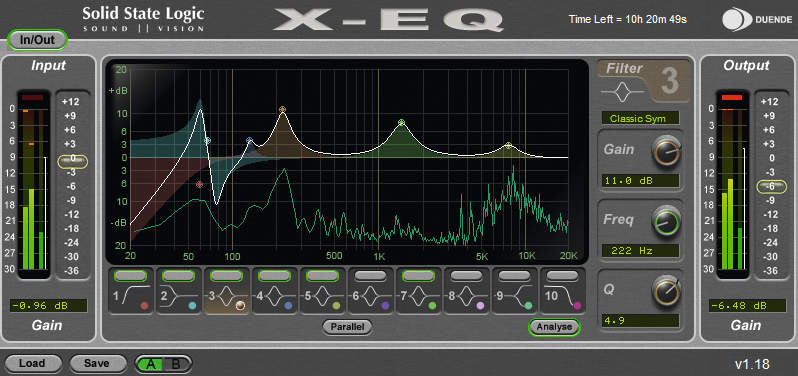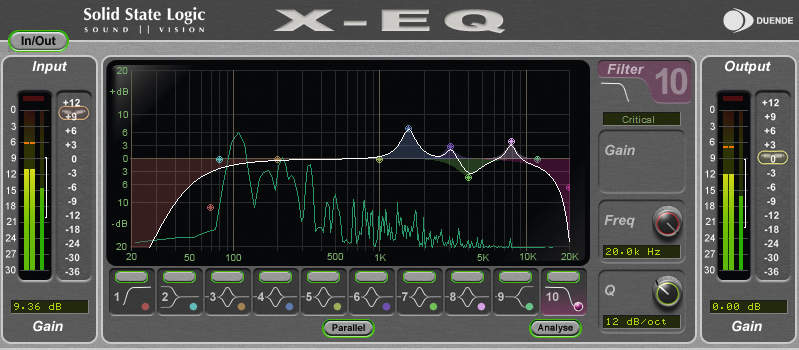MusicRadar Verdict
A couple of strange oversights aside, SSL´s expertise clearly shines through, as X-EQ is one of the best digital EQ plug-ins that we´ve had the pleasure of using
Pros
- +
Famous SSL sound quality, Well conceived, functional and versatile, Parallel mode sets it apart from many EQs, Built-in spectrum analyser, Covers all musical bases
Cons
- -
It ain’t cheap, Analyser lacks hold/averaging, No ‘A to B’ copy, Needs a Duende to run!
MusicRadar's got your back


Designed to run either on the SSL Duende Classic (10/10, cm105) or SSL's latest entry into the external DSP market, the all-new Duende Mini (see boxout opposite), X-EQ is a parametric EQ designed to combine "the best of the analogue and digital worlds". In practice, it recreates aspects of classic analogue equalisers but with certain qualities and characteristics that are only possible in a digital environment.
Getting the spec out of the way, X-EQ features much of what you might expect from an EQ plug-in and more besides. To take care of the bass and treble there are low- and high-pass filters with five different slopes and dedicated low- and high-frequency shelving filters. And the main guts of the beast? Six 'bell type' EQ bands, fully adjustable between 20Hz and 20kHz with highly tweakable Q, not to mention nine different bell shapes selectable per band, and a Parallel mode too (see boxout below). The amount of variation available from
the EQ shapes is too extensive to detail here, but in summary, there are symmetric and asymmetric shapes aplenty, and we couldn't devise a situation that they couldn't cover.
In keeping with all the other Duende plug-ins, X-EQ boasts excellent graphics that are easy on the eye,
and has lots of nice colour-coded touches. However, it'd be handy if the filter section automatically represented the last band activated - we kept inadvertently adjusting the wrong settings when tweaking!
Very handily, X-EQ features a real-time spectrum analyser that enables you to visualise the audio signal, and also pinpoint any irksome frequencies for attenuation or boosting. Since the analyser is post-EQ, you can also evaluate the effect that your EQ settings are having. One limitation is that the analyser doesn't have hold or RMS averaging functions, which would be very useful for isolating and displaying frequency 'trends' within source material.
Like most EQ plug-ins, there's an A/B function, but this would benefit greatly from a simple 'A to B' copy function, rather than us having to fiddle about saving and loading presets to achieve the same thing. On the upside, though, you can fully automate X-EQ in your host application - useful if conjuring filter sweeps is your bag.
Magic moments
While X-EQ isn't of a linear-phase design, SSL maintain that this is for sheer musical benefit, and that a non-linear phase EQ is more conducive to producing 'magic'. To get straight to the point, this is certainly the case here, for X-EQ has a sheer tonality and fidelity that sets it apart from most other EQs we've used. In fact, it can give uncannily similar results to that of a real SSL console - who'd have thought it?
At the end of the day, what most people want out of an EQ plug-in is musicality, versatility and functionality, but with a certain 'X-factor' that takes the sound above and beyond most others. With X-EQ, SSL have achieved this, and the minor niggles that we do have with it could very easily be accommodated in a future revision.
Want all the hottest music and gear news, reviews, deals, features and more, direct to your inbox? Sign up here.
MusicRadar is the number 1 website for music makers of all kinds, be they guitarists, drummers, keyboard players, djs or producers...
GEAR: We help musicians find the best gear with top-ranking gear round-ups and high- quality, authoritative reviews by a wide team of highly experienced experts.
TIPS: We also provide tuition, from bite-sized tips to advanced work-outs and guidance from recognised musicians and stars.
STARS: We talk to musicians and stars about their creative processes, and the nuts and bolts of their gear and technique. We give fans an insight into the actual craft of music making that no other music website can.
